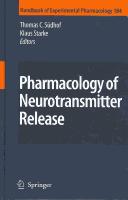| Listing 1 - 10 of 23 | << page >> |
Sort by
|
Book
ISBN: 0750337710 0750337702 Year: 2022 Publisher: Bristol [England] (Temple Circus, Temple Way, Bristol BS1 6HG, UK) : IOP Publishing,
Abstract | Keywords | Export | Availability | Bookmark
 Loading...
Loading...Choose an application
- Reference Manager
- EndNote
- RefWorks (Direct export to RefWorks)
This book is divided into three sections: 1) components of exocytotic pathways; 2) biophysical insights from synthetic and reconstituted systems; and, 3) physiological systems of exocytosis.
Exocytosis. --- Exocytosis. --- Health & personal development. --- MEDICAL / General.

ISBN: 0897668510 Year: 1994 Volume: 710 Publisher: New York, NY : New York Academy of Sciences,
Abstract | Keywords | Export | Availability | Bookmark
 Loading...
Loading...Choose an application
- Reference Manager
- EndNote
- RefWorks (Direct export to RefWorks)
Toxins --- Congresses --- Exocytosis --- Biological transport --- Research --- Methodology --- Exocytosis - Congresses. --- Biological transport - Research - Methodology - Congresses. --- Toxins - therapeutic use - congresses. --- Exocytosis - physiology - congresses. --- TOXINS --- EXOCYTOSIS --- PHYSIOLOGY
Dissertation
Abstract | Keywords | Export | Availability | Bookmark
 Loading...
Loading...Choose an application
- Reference Manager
- EndNote
- RefWorks (Direct export to RefWorks)
Asbestos --- Exocytosis --- Macrophages --- Endocytosis --- metabolism --- drug effects --- drug effects

ISBN: 0897668529 Year: 1994 Publisher: New York New York Academy of Sciences
Abstract | Keywords | Export | Availability | Bookmark
 Loading...
Loading...Choose an application
- Reference Manager
- EndNote
- RefWorks (Direct export to RefWorks)
Human physiology --- Biological transport --- Exocytosis --- Toxins --- Research --- Methodology --- Congresses. --- physiology --- congresses. --- therapeutic use --- Physiology --- Therapeutic use

ISBN: 9783540748045 9783540748052 Year: 2008 Publisher: Berlin, Heidelberg Springer-Verlag Berlin Heidelberg
Abstract | Keywords | Export | Availability | Bookmark
 Loading...
Loading...Choose an application
- Reference Manager
- EndNote
- RefWorks (Direct export to RefWorks)
It has been known for half a century that neurotransmitters are released in preformed quanta, that the quanta represent transmitter-storing vesicles, and that release occurs by exocytosis. The focus of this book is twofold. In the first part, the molecular events of exocytosis are analysed. This includes a discussion of presynaptic calcium channels, the core proteins of the secretory machinery, and the actions of clostridial toxins and a -latrotoxin, famous for their potency as well as their crucial role in the elucidation of the steps of exocytosis. In the book's second part, the presynaptic receptors for endogenous chemical signals are presented that make neurotransmitter release a highly regulated process. These include ligand-gated ion channels and presynaptic G-protein-coupled receptors. The targets of presynaptic receptors within the exocytosis cascade, and their therapeutic potential, are subjects addressed in the majority of chapters.
Exocytosis. --- Neurotransmitter receptors. --- Neurotransmitters. --- Neurotransmitter Agents --- Receptors, Neurotransmitter. --- Synaptic Transmission. --- Secretion.
Book
Year: 2014 Publisher: Frontiers Media SA
Abstract | Keywords | Export | Availability | Bookmark
 Loading...
Loading...Choose an application
- Reference Manager
- EndNote
- RefWorks (Direct export to RefWorks)
The regulated secretory pathway is a hallmark of neuroendocrine cells. This process comprises many sequential steps, which include ER-associated protein synthesis, post-translational modification of proteins in the Golgi complex, sorting and packing of secretory proteins into carrier granules, cytoskeleton-based granule transport towards the plasma membrane and tethering, docking and fusion of granules with specialized releasing zones. Each stage is subjected to a rigorous regulation by a plethora of factors that function in a spatially and temporarily coordinated fashion. Much effort has been devoted to characterize the precise role of the regulatory proteins participating in the different steps of this process and to identify new factors in order to obtain a unifying picture of the secretory pathway. In spite of this and given the enormous complexity of the process, certain stages are not fully understood yet and many players remain to be identified. The aim of this Research Topic is to gather review articles and original research papers on the molecular mechanisms that govern and ensure the correct release of neuropeptides.
Neuroendocrinology. --- Paraneurons. --- Neuroendocrine Cells --- regulated exocytosis --- Endocytosis --- secretion --- large dense core vesicles --- Membrane trafficking --- super-resolution microscopy --- Neuroendocrine Cells --- regulated exocytosis --- Endocytosis --- secretion --- large dense core vesicles --- Membrane trafficking --- super-resolution microscopy
Book
Year: 2014 Publisher: Frontiers Media SA
Abstract | Keywords | Export | Availability | Bookmark
 Loading...
Loading...Choose an application
- Reference Manager
- EndNote
- RefWorks (Direct export to RefWorks)
The regulated secretory pathway is a hallmark of neuroendocrine cells. This process comprises many sequential steps, which include ER-associated protein synthesis, post-translational modification of proteins in the Golgi complex, sorting and packing of secretory proteins into carrier granules, cytoskeleton-based granule transport towards the plasma membrane and tethering, docking and fusion of granules with specialized releasing zones. Each stage is subjected to a rigorous regulation by a plethora of factors that function in a spatially and temporarily coordinated fashion. Much effort has been devoted to characterize the precise role of the regulatory proteins participating in the different steps of this process and to identify new factors in order to obtain a unifying picture of the secretory pathway. In spite of this and given the enormous complexity of the process, certain stages are not fully understood yet and many players remain to be identified. The aim of this Research Topic is to gather review articles and original research papers on the molecular mechanisms that govern and ensure the correct release of neuropeptides.
Neuroendocrinology. --- Paraneurons. --- Neuroendocrine Cells --- regulated exocytosis --- Endocytosis --- secretion --- large dense core vesicles --- Membrane trafficking --- super-resolution microscopy
Book
Year: 1993 Publisher: Katwijk All In
Abstract | Keywords | Export | Availability | Bookmark
 Loading...
Loading...Choose an application
- Reference Manager
- EndNote
- RefWorks (Direct export to RefWorks)
Calcium --- Exocytosis --- Flow Cytometry --- Neutrophils --- Guanosine 5'-O-(3-Thiotriphosphate) --- Cell Membrane Permeability --- pharmacology --- drug effects --- methods --- drug effects --- pharmacology
Book
Year: 2014 Publisher: Frontiers Media SA
Abstract | Keywords | Export | Availability | Bookmark
 Loading...
Loading...Choose an application
- Reference Manager
- EndNote
- RefWorks (Direct export to RefWorks)
The regulated secretory pathway is a hallmark of neuroendocrine cells. This process comprises many sequential steps, which include ER-associated protein synthesis, post-translational modification of proteins in the Golgi complex, sorting and packing of secretory proteins into carrier granules, cytoskeleton-based granule transport towards the plasma membrane and tethering, docking and fusion of granules with specialized releasing zones. Each stage is subjected to a rigorous regulation by a plethora of factors that function in a spatially and temporarily coordinated fashion. Much effort has been devoted to characterize the precise role of the regulatory proteins participating in the different steps of this process and to identify new factors in order to obtain a unifying picture of the secretory pathway. In spite of this and given the enormous complexity of the process, certain stages are not fully understood yet and many players remain to be identified. The aim of this Research Topic is to gather review articles and original research papers on the molecular mechanisms that govern and ensure the correct release of neuropeptides.
Neuroendocrinology. --- Paraneurons. --- Neuroendocrine Cells --- regulated exocytosis --- Endocytosis --- secretion --- large dense core vesicles --- Membrane trafficking --- super-resolution microscopy

ISBN: 0123644925 9780080586298 0080586295 9780123644923 9786611442781 6611442782 128144278X Year: 1984 Volume: 92 Publisher: Orlando ; London : Academic Press,
Abstract | Keywords | Export | Availability | Bookmark
 Loading...
Loading...Choose an application
- Reference Manager
- EndNote
- RefWorks (Direct export to RefWorks)
INTERNATIONAL REVIEW OF CYTOLOGY V92
Histology. Cytology --- Translation, Genetic --- Endocytosis --- CELL NUCLEUS --- TRANSFECTION --- Exocytosis --- GENETICS --- Genetics. --- Cells. --- Cytology. --- Biology --- Cells --- Cell biology --- Cellular biology --- Organisms --- Cytology --- Embryology --- Mendel's law --- Adaptation (Biology) --- Breeding --- Chromosomes --- Heredity --- Mutation (Biology) --- Variation (Biology)
| Listing 1 - 10 of 23 | << page >> |
Sort by
|

 Search
Search Feedback
Feedback About UniCat
About UniCat  Help
Help News
News